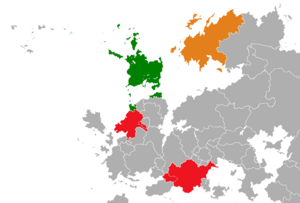Aldinean Cold War: Difference between revisions
No edit summary |
No edit summary |
||
| Line 86: | Line 86: | ||
| campaignbox = | | campaignbox = | ||
}} | }} | ||
The '''Aldinean Cold War''', sometimes referred to as the '''Ambrose-Sjealand Cold War''', '''Aldinean Conflict''' or the '''Ambrose-Sjealand Conflict''' is the ongoing struggle for influence and hegemony in [[Aldinea]], the [[Lazarene Sea]] and parts of [[Sirklant]] and [[Miklea]] between the [[Archkingdom of Sjealand]] and [[Ambrose|Confederal Republic of Ambrose]]. The two countries are regional and great powers and both are the leaders of two respective networks of alliances, Sjealand leading the [[West Aldinean Defence Organisation]] and Ambrose the [[Golden Circle Pact]]. The two countries have provided varying degrees of support to opposing sides in conflicts across the world, including the [[War in Weichtal]] and the [[War in North Alaouasem]]. | |||
Beginning in the early 1970's with the [[War of the Njord]] and the [[Engatian Split]], the cold war has drawn significant lines between Aldinean states and even those abroad, as the two blocs have sought to extend their influence at the cost of the other. Despite a brief détente the conflict is now at the hottest it has ever been, being waged on multiple levels over geopolitical, economic and cultural influence, with the end goal being dominance of Aldinea, and regional economic hegemony. | |||
While many people sea it as a conflict between the generally monarchist Sjealand and the republican Ambrose, the conflict has many more layers, with [[West Aldinean Defence Organisation|WADO]] including and supporting republics and [[Golden Circle Pact|the GCP]] aiding various monarchies. Generally the conflict can be seen as a conflict between traditionally mercantile states like [[Sjealand]] with globalised economies against more inland states with more autarkic goals. | |||
==History== | |||
==Involved Parties== | |||
==Involvement in regional conflicts== | |||
==Nuclear conflict== | |||
Revision as of 15:04, 16 November 2019
| Aldinean Cold War | |||||||
|---|---|---|---|---|---|---|---|
 Sjealand Ambrose Major proxy conflict locations | |||||||
| |||||||
| Belligerents | |||||||
|
Other allies and proxies: |
Other allies and proxies: | ||||||
|
|
| ||||||
| Commanders and leaders | |||||||
|
(Marshal of the Sea of Njord) |
| ||||||
| Units involved | |||||||
|
WADO Armed Forces: |
GCP Armed Forces:
| ||||||
The Aldinean Cold War, sometimes referred to as the Ambrose-Sjealand Cold War, Aldinean Conflict or the Ambrose-Sjealand Conflict is the ongoing struggle for influence and hegemony in Aldinea, the Lazarene Sea and parts of Sirklant and Miklea between the Archkingdom of Sjealand and Confederal Republic of Ambrose. The two countries are regional and great powers and both are the leaders of two respective networks of alliances, Sjealand leading the West Aldinean Defence Organisation and Ambrose the Golden Circle Pact. The two countries have provided varying degrees of support to opposing sides in conflicts across the world, including the War in Weichtal and the War in North Alaouasem.
Beginning in the early 1970's with the War of the Njord and the Engatian Split, the cold war has drawn significant lines between Aldinean states and even those abroad, as the two blocs have sought to extend their influence at the cost of the other. Despite a brief détente the conflict is now at the hottest it has ever been, being waged on multiple levels over geopolitical, economic and cultural influence, with the end goal being dominance of Aldinea, and regional economic hegemony.
While many people sea it as a conflict between the generally monarchist Sjealand and the republican Ambrose, the conflict has many more layers, with WADO including and supporting republics and the GCP aiding various monarchies. Generally the conflict can be seen as a conflict between traditionally mercantile states like Sjealand with globalised economies against more inland states with more autarkic goals.